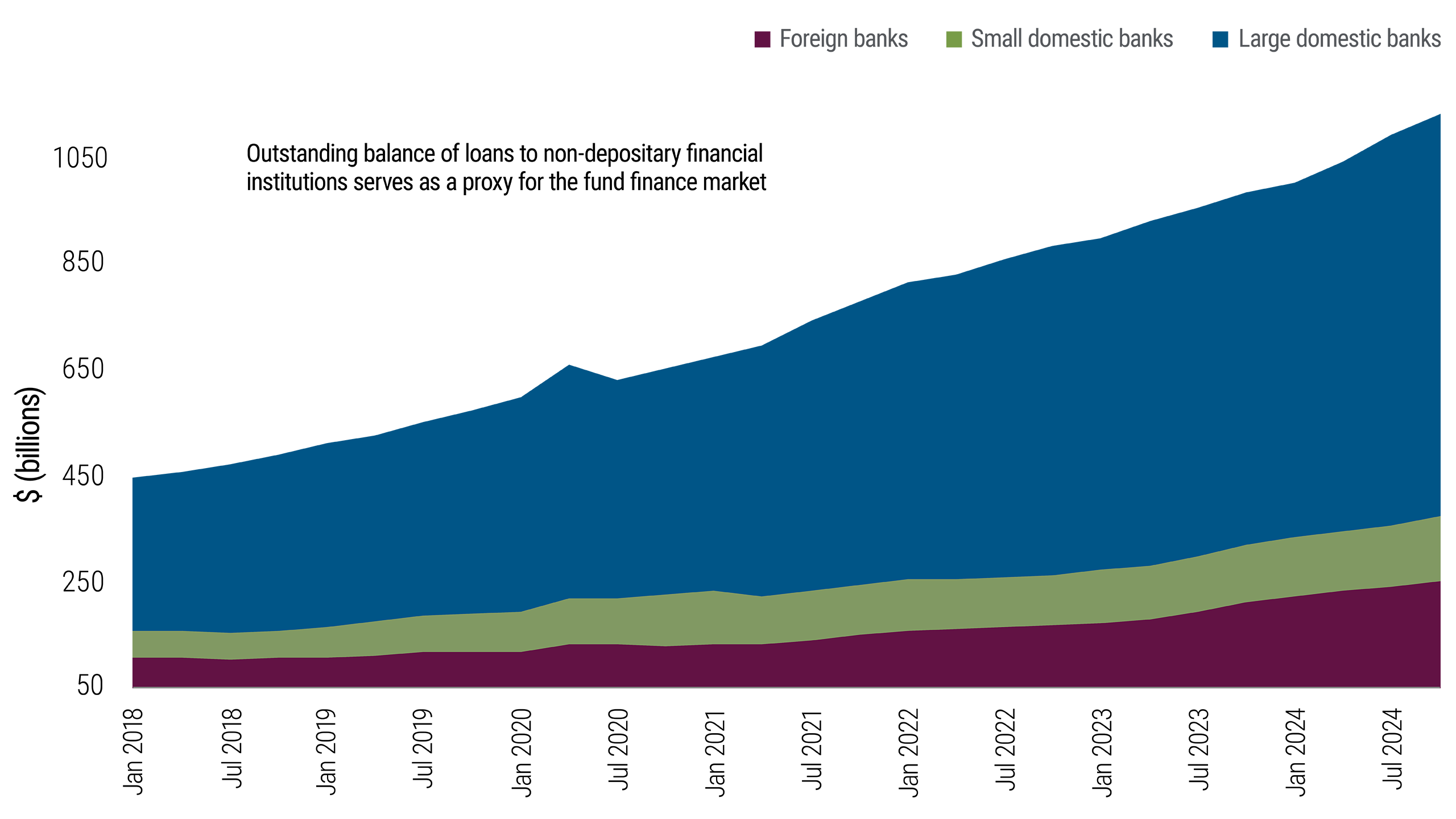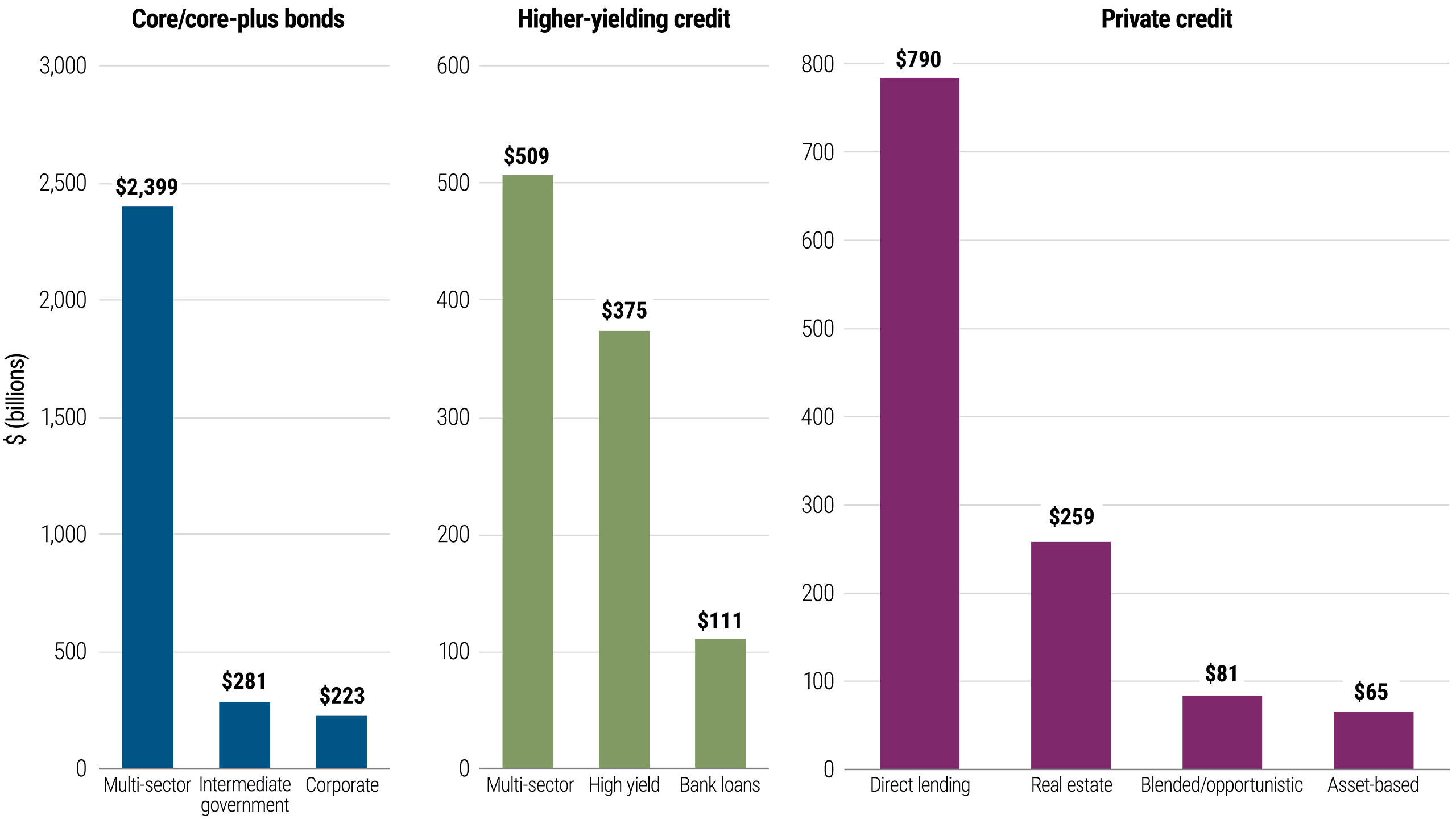


Key takeaways
- Private credit has grown rapidly during a highly supportive and unique period in financial history, but the largest sector – corporate direct lending – shows signs of maturing as competition intensifies and the economic outlook grows more uncertain.
- Many aspects of corporate direct lending resemble passive approaches to syndicated bank loans, but with higher fees, less liquidity, and limited exit options for investors.
- Today’s starting conditions appear to favor more strategic investing across a wider array of asset types and a focus on maximizing outcomes rather than simply offering market access.
- Expansion in the available forms of private credit is creating opportunities to pursue enhanced risk-adjusted returns, applying a playbook similar to what has been effective in public fixed income and credit over many decades.
- Interplay between public and private markets is accelerating these trends, broadening the toolkit for active managers with scale and resources across various forms of public and private credit.
After more than a decade of consistent growth, private credit markets are maturing. What gained traction as a corporate direct lending community making floating-rate loans to highly leveraged companies has transitioned to a vast, diverse market that touches almost every sector of the economy.
A rare alignment of forces propelled private credit’s initial expansion: rock-bottom interest rates, tighter bank regulation in the wake of the financial crisis, and a surge of capital in pursuit of yield. As the “easy money era” fades and investor capital catches up with available lending opportunities, the investment landscape is changing.
Private credit is no longer solely about gaining access to a new asset class and capturing a perceived illiquidity premium. Now, higher rates and growing economic uncertainty are reintroducing more traditional cyclical forces, particularly to lower-quality credit markets.
Meanwhile, changes to bank business models – spurred by elevated rates, evolving regulations, and stress in real estate markets – are fueling growth across various forms of corporate and asset-based finance. Investors now have access to a more diverse array of credit types, each with distinct characteristics, risk profiles, and starting conditions.
The boundaries between public and private markets are also blurring, allowing investors to pursue relative value across a much broader landscape. This new environment should favor investors who can master asset selection and portfolio construction. Much like in public fixed income, success in private credit will increasingly depend on the ability to spot mispricings, navigate structural inefficiencies, and exploit market dislocations.
Such dislocations can be easy to come by when some markets closely track moves in interest rates and credit spreads, while other private sectors use opaque pricing mechanisms with relatively “sticky” marks, meaning they are slow to adapt to prevailing conditions. The “smoother” return experience that many private credit investors have experienced to date has created attractive opportunities for active managers to capitalize on pricing and liquidity differences across various public and private credit assets.
Many approaches to private markets still rely on access, placing far less emphasis on relative value – a contrast similar to the active versus passive conversation in public fixed income and credit. We believe the active opportunities in private credit will rival, or potentially exceed, the excess value that has been created by active management in fixed income markets in recent decades. We see increasing opportunities for well-resourced investment managers in three main areas:
- Finding relative value across public and private markets: Comparing similar credit profiles to identify opportunities.
- Focusing on sector and asset selection: Carefully evaluating risks and rewards across different subsectors, and analyzing individual assets and deal structures.
- Capitalizing on structural alpha: Leveraging market inefficiencies to uncover additional value.
Below, we explore these three approaches in more detail.
Public versus private credit market relative value
The once-clear boundaries between public and private credit markets are blurring, and the investment landscape is changing with them. The rising interplay between public and private markets can be seen in various forms:
- Collateralized loan obligations (CLOs) – structured credit products backed by corporate syndicated leveraged loans – are becoming an increasingly important financing tool for private credit, with private credit CLOs now accounting for nearly 12% of the CLO market and 18% of CLO issuance in 2024, according to J.P. Morgan data.
- Other private asset classes such as residential mortgages, aviation finance, and music royalties are often originated in private markets and then sold to public markets through securitizations, which involve pooling these assets and selling them as securities.
- Synthetic risk transfer (SRT) transactions are an increasingly popular tool for banks to offload risk through custom private deal structures that reference the performance of portfolios of public and private credit exposure.
It’s not only asset types that are converging. While fundamentals have historically moved in tandem across public and private markets, there is also a growing connectedness stemming from technical factors, specifically market dynamics influenced by fund flows. Just as fund flows influence technical dynamics in public markets, investment vehicles such as business development companies (BDCs) are increasingly important in capital formation within private credit, especially in corporate direct lending.
This rising technical influence has accelerated as relatively low merger and acquisition (M&A) and leveraged buyout (LBO) activity has left too much capital (see Figure 1) chasing too few direct lending deals, especially in midsize and upper middle market transactions. We observed similar behavior in real estate markets during the rise of non-traded real estate investment trusts (REITs) prior to the interest rate shock of 2022.
Since then, semi-liquid real estate strategies, as well as evergreen, core-focused real estate vehicles, have experienced more redemption pressure. Although this hasn’t led to widespread forced selling to date, the transition has affected the technical backdrop in real estate markets, and persistent outflows could create motivated selling activity over time.
Volatility in public markets has highlighted the perceived stability of private credit. However, this stability often comes with a trade-off: Lending terms may be less favorable than those in public markets, and the much-touted “certainty of execution” tends to benefit borrowers more than investors.
The pathways to secondary transactions in private credit are also expanding (see Figure 2). What began as a niche focused on secondary fund sales and transfers of limited partner interests – ownership stakes in private credit funds – is evolving into a broader marketplace that includes fund finance, risk transfer tools, and portfolio and single-asset sales. We expect these trends to persist, offering new opportunities for relative value.
Rather than creating a competition between public and private credit, this market intersection is giving investors a broader set of tools. The real challenge is not choosing one market over the other, but navigating an expanding array of structures, sectors, and technical factors to find the optimal balance of risk and return.
Sector and asset selection
Despite this growing interplay between markets, private credit still stands out when it comes to investment strategy types and investor preferences.
In public fixed income, the largest fund categories typically use flexible approaches that span multiple sectors instead of focusing on just one. In higher-quality core fixed income, flexible strategies are more common than those targeting only investment grade (IG) corporate bonds or mortgages. Similarly, in higher-yielding categories, multi-sector funds outnumber those focused on specific areas such as high yield or bank loans.
By contrast, the private credit fund landscape has largely favored sector-specific strategies (see Figure 3).
Flexible, actively managed funds are well-positioned to look across different sectors and invest based on relative value rather than following rigid mandates. We see an increasing, largely untapped opportunity in private markets to extract value and enhance risk-adjusted returns through diversification, sector allocation, and asset selection – an approach PIMCO has honed for more than 50 years.
Public credit investors generally wouldn’t place nearly all of their allocation in the bank loan market. Similarly, private credit investors shouldn’t rely solely on corporate direct lending. Instead, investors should use diversification as a tool to navigate cycles. We believe diversification has never been more achievable than it is today, as higher interest rates and bank retrenchment open scalable opportunities in private asset classes beyond corporate credit.
Just as in public markets, private credit investors can emphasize or de-emphasize subsectors according to the most attractive overall compensation for risk. This can be based on sector allocations (e.g., corporate, asset-based, real estate) or a granular focus on subsectors offering the most attractive risk/reward profile. This often requires careful application of data and analytical models – akin to option-adjusted frameworks in fixed income – to assess specific differences and derive an overall measure of risk compensation.
Starting conditions and valuations can differ significantly across sectors. In corporate lending, leverage levels are elevated versus historical norms. In asset-based finance, valuations and deal structures appear more attractive. Meanwhile, real estate markets are recovering from a challenging cycle.
Today, we find higher-quality, private, consumer-related credit is far more attractive than most forms of corporate credit, due to a combination of stronger lending standards, lower starting leverage levels, and favorable valuations.
Structural alpha
We also see structural alpha playing a growing role in private credit. This concept involves identifying repeatable structural inefficiencies in markets – e.g., decisions made by noneconomic investors such as insurance companies, whose primary objectives often emphasize net investment income versus total return – and creating a diversified portfolio of these inefficiencies, allowing investors to capitalize on value dislocations.
As private credit has matured, it now features a more formal market structure, with a wider range of participants, investment vehicles, risk-transfer mechanisms, and regulatory oversight. We see four increasingly relevant sources of structural alpha:
- Preferred habitat: This is a theory typically applied to the bond market, focusing on investor preference for bonds based on their term structure. For example, some investors who favor short-duration bonds will do so almost regardless of relative value versus longer-duration investments. An analog in private markets would be that many investors continue to focus on floating-rate credit as a means to reduce mark-to-market sensitivity to interest rate changes. This in turn creates much less crowding in opportunities within fixed-rate, or longer-duration, private credit. Aviation finance is an example of an area that falls outside of the preferred habitat of many private credit investors, which can result in more attractive risk-adjusted return profiles.
- Noneconomic participants: We have seen increasing private market activity from noneconomic buyers from multiple vantage points:
- Evergreen fund flows: In public markets, flows into and out of passive funds can drive structural alpha. In private markets, inflows have fueled significant growth in relatively narrow, evergreen private strategies such as BDCs and REITs. These vehicles, which tend to be more beta-focused, may need to deploy capital quickly and can be subject to monthly or quarterly redemptions, creating market distortions. Recently, BDCs have contributed to narrower direct lending spreads and elevated redemption activity in evergreen real estate vehicles. This has allowed PIMCO to source triple net lease real estate assets with long-term leases to well-known corporate tenants at attractive spreads relative to similar unsecured corporate credit risk.
- Insurance capital: Insurance demand for private credit has surged over the past decade, driven by a focus on capital efficiency – either through assets with favorable credit ratings or those that receive preferential regulatory treatment. This influx has led to significant spread compression in assets prized for their capital efficiency, such as IG private credit and fixed-rate commercial mortgage loans, often making their pricing or terms less attractive versus more liquid market alternatives. PIMCO has capitalized on this strong bid for private IG credit by obtaining attractive senior financing on complex asset-based portfolios.
- Bank risk disposition: Banks typically want the client relationship that accompanies loan origination, but regulations and risk management often incentivize banks to dispose of the asset. The result has been a variety of portfolio sales, forward flow arrangements, and risk transfer transactions. The common theme: a market participant motivated to offload risk for reasons other than maximizing value. PIMCO has benefited from this trend by investing in mortgage and consumer portfolios from banks, while also stepping into flow arrangements with platforms seeking capital partners.
- Ratings: The growth of private credit has contributed to the rise of private IG credit assets. The implications of this trend are twofold:
- Security selection within IG markets: We often observe private credit investments that carry an IG rating from one rating agency but do not have the characteristics investors expect from IG credit. Such differences can be due to repayment priority, deal structure complexity, or borrower credit quality. These issues often mean inferior compensation compared with similar investment opportunities.
- Financing opportunities in private credit: Robust demand for private credit with an IG rating allows active managers to extract additional value by structuring deals to optimize for a rating agency rating, thus benefiting from attractive financing. This requires deep expertise in structured credit, rating agency methodologies, and capital structure relative value analysis. Given growing demand for private credit among insurance companies (see Figure 4) and other investors seeking the perceived safety of an IG rating, we expect this trend to continue.
- Behavioral finance: Much of the enthusiasm for private credit stems from its strong run during the relatively unprecedented investment environment of the past 15 years. But clinging to a backward-looking strategy that leans heavily on lower-quality, floating-rate and structurally leveraged credit is dangerous in today’s higher-rate world. Success now demands a balanced mix of fixed- and floating-rate assets, a willingness to embrace longer durations, and a focus on relative value across credit sectors. Simply put, yesterday’s approach won’t cut it in tomorrow’s market.
Conclusion
As private credit matures, it is no longer defined by the pursuit of access or the novelty of alternative lending. Today, it represents a multi-faceted arena offering exposure to diverse borrower profiles and deal structures. The blurring lines between public and private markets, the proliferation of asset types, and the growing influence of technical and structural factors have created a landscape rich with opportunity.
Success in this new era will depend less on being early and more on being discerning. Investors must be able to assess relative value, understand the nuances of different vehicles and structures, and respond nimbly to shifting market dynamics. The toolkit for pursuing returns is larger than ever, but so too is the need for rigorous analysis and active management.
Ultimately, private credit’s coming of age will most likely favor investors who combine flexibility, discipline, and a keen eye for value. Those who can look beyond headline yields and embrace a more nuanced, strategic approach should be well-positioned to capture the market’s rewards.





